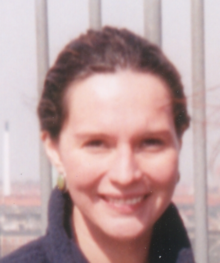
Summary
Alicia Margarita Soderberg (born 1977) is an American astrophysicist whose research focused on supernovae. She was an assistant professor of astronomy at Harvard University and a postdoctoral fellow at the Harvard-Smithsonian Center for Astrophysics.
Alicia M. Soderberg | |
|---|---|
 A. M. Soderberg on top of Rundetaarn in 2001. | |
| Born | 1977 (age 46–47) Boston |
| Nationality | American |
| Education | PhD, California Institute of Technology |
| Alma mater | California Institute of Technology |
| Scientific career | |
| Fields | Astrophysics |
| Institutions | Harvard University |
| Doctoral advisor | Shrinivas Kulkarni |
Early life edit
Born in Boston, Soderberg was raised in Falmouth, Massachusetts on Cape Cod, and graduated from Falmouth High School. She also spent summers at the nearby Woods Hole Oceanographic Institution studying the effect of water pollution on coastal ponds.[1]
Education edit
Soderberg attended Bates College, where she graduated with a Bachelor of Science degree in 2000 with a double major in Math and Physics. During her undergraduate years, she also participated in a number of summer programs, including the Center for Astrophysics | Harvard & Smithsonian, the Cerro Tololo Inter-American Observatory in Chile, and the Los Alamos National Laboratory in New Mexico. She then earned a Master of Science from the University of Cambridge in Applied Mathematics. Soderberg was awarded her doctorate in astrophysics from the California Institute of Technology under the guidance of advisor Shrinivas Kulkarni, where her thesis used data gathered from the Palomar Observatory and the Very Large Array to provide a better understanding of gamma ray bursts and stripped core-collapse supernovae.[2]
Career edit
On February 18, 2006, Soderberg was a member of a group of researchers who detected the gamma-ray burst GRB 060218 located 440 million light years (135 Mpc) away in the constellation Aries. The detection of the associated supernova SN2006aj provided one of the best evidence to date tying gamma-ray bursts and supernovae.[3]
Soderberg and her colleagues detected the supernova SN 2008D as it was occurring on January 9, 2008, using data from NASA's Swift Gamma-Ray Burst Mission X-ray space telescope, from a precursor star in the spiral galaxy NGC 2770, 88 million light years away (27 Mpc). They alerted eight other orbiting and ground-based observatories to record the event.[4][5] The team was able to catch the supernova in action because they had been making observations of NGC 2770 to observe supernova SN 2007uy.[6]
Awards and honors edit
- Annie Jump Cannon Award in Astronomy (2009)[7]
References edit
- ^ Bates News (December 14, 1999). "Mashpee student makes stellar discoveries". Bates. Bates College. Retrieved October 29, 2021.
- ^ Short Biography: Alicia Soderberg, Harvard University. Accessed September 7, 2010.
- ^ Reddy, Francis. "A supernova caught in the act: Astronomers around the world watched as an underpowered gamma-ray burst evolved into an exploding star.", Astronomy Magazine, August 30, 2006. Accessed September 7, 2010.
- ^ Overbye, Dennis. "Scientists See Supernova in Action", The New York Times, May 22, 2008. Accessed September 7, 2010.
- ^ Editorial. "In at the Birth of Death", The New York Times, June 2, 2008. Accessed September 7, 2010.
- ^ Thompson, Andrea. "Supernova Birth Observed for First Time", Space.com, May 21, 2008. Accessed September 7, 2010.
- ^ "Annie Jump Cannon Award in Astronomy | American Astronomical Society". aas.org. Retrieved October 8, 2018.


